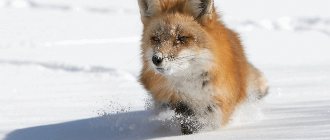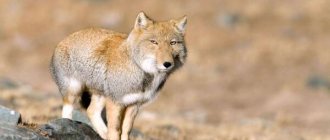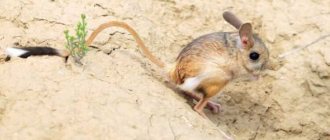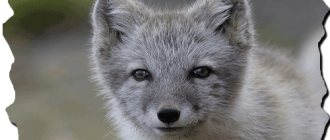Foxes belong to the canine family of mammals. They have been admired by peoples all over the world since ancient times; a large number of legends and fairy tales are associated with them. Since childhood, people have heard about fox cunning, and this fact is not fiction - animals are really smart and quick-witted, which helps them survive in nature.
The fox's cunning is not an exaggeration
In the modern world, their main enemies are people, but the animals continue to live successfully in forests near cities and towns, and even periodically visit them for prey. You can tell a lot about them, so in this article we have collected the most interesting facts about foxes.
№1
They belong to the Canidae family, which makes them related to wolves and dogs. However, in their behavior they are more reminiscent of cats. Firstly, like cats, they are mostly active after sunset. Secondly, like cats, foxes have vertical pupils. Thirdly, foxes, like cats, can climb trees (gray ones), yes, yes, they can. Moreover, they are the only representatives of the Canidae family that can retract their claws (we are again talking about gray foxes). Fourthly, their hunting style is practically no different from a cat's. They also set up ambushes (for example, wolves do not do this) and pounce on prey at the first opportunity. Fifthly, foxes, like cats, have sensitive whiskers on their faces. Therefore, foxes have more in common with cats than with their family brothers.
Foxes in myths and legends
The fox is often found in Japanese, Korean and Chinese myths and legends. These are spirits who are good-natured towards people, know how to read minds, turn into a person, and their main purpose is to monitor the balance of evil and fight. The most famous Japanese mythological foxes are Kitsune and Hokkaido. The first has a variety - Nogitsune, which in myths is an unkind deceiver. However, these creatures usually deceived those people who themselves possessed a large number of negative qualities. In Korean myths, these animals have the ability to bewitch.
Fox in Russian folk tales
Among European peoples, the fox in folklore was mainly associated with trickery and cunning. And the indigenous peoples of America, on the contrary, revered the animal, and even held holidays in honor of it.
Fox in North American Indian myths
The fox is also found in ancient Greek mythology, where it was an evil Teumes beast that devoured people and ravaged the surrounding area. According to legend, she was chased by a copper dog named Lylaps, but as a result Zeus stopped the chase, turning both animals into celestial constellations.
№3
They are very good parents. Foxes breed once a year. In one litter, from 1 to 11 babies are born (on average 6). Babies are born absolutely helpless: they are blind and do not open their eyes for 9 days after birth. During this period, they stay with their mother in the den, while their father hunts and brings them food. Once in England, a case was recorded when a baby got stuck in a wire mesh and stayed there for 2 whole weeks. He survived because his mother brought him food every day.
Mouse
In winter, most of the food sources disappear, fly south, fall asleep deep in burrows, there is practically no plant food, and then the fox is rescued by voles, which are always available. In winter, you can often see a red-haired predator performing an intricate dance on the field. This is mouseing.
Having heard and smelled the nesting of voles, the fox begins to dance in one place, bouncing on its hind legs and hitting the snow or ground with force with its front legs. Then all she has to do is catch the frightened mice running out of their holes. Sometimes she dives into the snow with her muzzle at a run and can fall under the snow up to half her body. Each such dive is rewarded with the presence of prey in the fox’s mouth.
№4
Fennec fox is the smallest fox on the planet. In size it is even inferior to a domestic cat. The fennec cat lives in the Sahara Desert, where it sleeps during the day to protect itself from the scorching sun. His large ears are needed not only to hear well, but also to cool his body. The fennec's paws are covered with fur, which allows him to move on hot sand without any problems.
Decorative fox
Fenech is a very active and nimble animal. His cute appearance attracts glances: it’s impossible not to fall in love with his big ears and black beady eyes!
The size of the animal is very modest: with a body length of about 40 centimeters, the animal weighs 1.5-2 kilograms. Fennecs are distinguished by their cunning and slightly capricious character, although they get along well with humans and cats. They don’t mind playing with their friends (for example, hide and seek or tag).
It is worth keeping fennecs in a spacious cage, which replaces a hole for small hunters. It is worth equipping the shelter with warm, soft towels that will be comfortable to lie on.
Ornamental chanterelles are very difficult to tolerate temperature changes (especially cold snaps). Fennecs feel comfortable in well-heated rooms.
Mini foxes need to be combed regularly. Use soft bristle brushes or small fine-toothed combs for this procedure. Fennec himself really likes this type of fur care.
You can use a litter box for desert foxes as a litter box. Fennecs are very smart, so they quickly understand what this item is for.
№7
Foxes have beautiful fur, and as a result they have become a real gold mine for fur clothing manufacturers. 85% of fox fur items come from foxes bred in captivity. There they are kept in small cages in which the animals cannot even turn around. Since producers have one goal - to get good fur, they electrocute the animals so as not to damage the fur. Therefore, when you think about purchasing a fox fur coat, remember how this fur was obtained.
Fox Habits
The fox is a good hunter . In addition to observation and intelligence, she has excellent visual memory, a good sense of smell and acute hearing. A mouse squeaks barely audibly, and the Fox hears it a hundred meters away; a vole rustles through dry grass under a half-meter layer of snow - and it will be heard. It climbs well, swims well, and is extremely maneuverable on the shore. Her ingenuity on the hunt or when escaping from pursuers is admirable.
A fox will be able to climb a tree if it is slightly inclined or branches low from the ground. The fox is very active. She knows her hunting area down to the smallest detail and systematically inspects it. In winter, patterned chains of Fox tracks intricately cross fields, copses, and ravines, getting lost on roads and paths and intertwining around stacks of straw, piles of dry soybean stalks, piles of dead wood, and in other places where mice and voles live.
There was, and still is, an opinion that the main food of Foxes is hares . Of course, the Fox loves hare meat, but she can’t often catch up with a hare - how can she keep up with such a runner.
However, Foxes get along just fine without hare meat. It is estimated that the Fox's diet includes more than 300 different animals - from insects to large birds.
And yet the main food of the Fox is rodents . They take up 80-85% of her diet. To get enough, the Fox needs to catch and eat at least two dozen mice and voles a day. And where the Fox feeds - and the area of its feeding area is on average 10 kilometers in diameter - there are much fewer rodents than where there are no foxes.
After the rains, the fox collects earthworms in abundance. In shallow water, the Fox successfully catches fish , crayfish, and takes out shells. It happens that half-eaten prey remains, and then the Fox hides it, taking it to different places. Then she will certainly find these supplies and eat them.
It is characteristic that, being a typical predator, the Fox happily eats berries , apples, and some vegetables.
The Fox hunts , as a rule, at dusk and at night; during the day it can be seen only during the lean period, most often in winter, and even in summer, when fox cubs are growing.
The fox uses burrows mainly when raising offspring, and the rest of the time it prefers to rest in an open place: under the roots of an upturned tree, in a ravine, on a haystack.
№8
It is known that many animals use a magnetic field to determine the direction of movement. For example, leatherback turtles use a magnetic field to travel vast distances and find the beach where they were once born. This is where they lay their eggs. Some birds, sharks, etc. are also guided by the magnetic field. However, in the case of the fox, as scientists suggest, it uses the magnetic field not to navigate the terrain, but to find prey, which is a unique ability in the animal kingdom.
Where do they live?
The historical range of foxes is the north of the African continent, America, and Europe. They are found throughout almost the entire territory of Asia with the exception of some northern and southern territories.
The common fox was introduced to Australia in the mid-19th century. The main purpose of the introduction was to hunt breeding rabbits. In addition, the introduced animals themselves were supposed to become the object of sport hunting.
Foxes very quickly adapted to the new habitat, and their population in the south of the continent increased significantly. Currently, Australian foxes have become a serious threat to some local animal species: anteaters, dwarf kangaroos, marsupial badgers. Not long ago it was found that predators have learned to climb trees and hunt koalas.
Where does he live?
The fox prefers to settle in relatively open areas. In the forest it chooses edges and clearings, in the steppe it digs holes on hills and hills, and in mountainous regions it uses small caves as shelter.
Foxes are not migratory animals and spend their entire lives in one territory.
BROWN BEAR
№10
In the 1950s, a scientist from the Soviet Union began conducting experiments and was able to develop a new species of domesticated fox. His institute, located in Siberia, is still the only place where you can buy domesticated foxes. But, of course, it’s not cheap. For such a pet you will have to pay from 8,000 to 10,000 dollars.
However, before purchasing such a pet, you need to know that even domesticated foxes have a digging instinct, which is why they will simply dig up your entire garden. Also, fox urine stinks no worse than skunk urine, so if it marks an area in the apartment, for example, a sofa, then it will take a very long time to scrub it off or even throw it away.
We also recommend reading: Interesting facts about wolves
Types of foxes
The genus of fox from the wolf subfamily has 10 species: common, Afghan, American, sand, Tibetan and others.
Island foxes
There are also many genera of animals living in different regions of the planet, which, due to their external similarity, are also called foxes:
- Gray,
- Maikongi,
- Sekuranskie,
- Andean,
- Paraguayan,
- Island,
- Bengal and others.
Maikong fox
The most common are common foxes, or red foxes. They are found in European countries, most of Asia, North America, North Africa, and relatively recently this species was acclimatized in Australia.
Throws hedgehogs into the water so that they open up
The fox is really cunning and witty. There are not many animals in nature that pose a danger to hedgehogs. However, foxes cope with the obstacle in the form of needles. We decided to throw sea urchins into the water.
As soon as the cunning finds its future lunch, it begins to roll it to the nearest body of water. There the hedgehog instinctively opens up, the needles get wet and nothing else can stop the fox from biting.
However, hedgehogs are believed to have an unpleasant odor, so foxes only eat them if they are hungry.
The tail helps keep you warm in winter and maintain balance.
For a fox, a tail is not only a source of pride. It has a very important function - it helps the animal survive.
When running fast, when foxes develop high speed, it serves as a kind of balance and helps not to lose balance.
In addition, with its help this cunning animal can turn very quickly. When being chased and in danger of life, they simply turn it sharply at a right angle, and due to this they quickly turn around themselves. The tail can store supplies for the worst case of famine. Animals use it to cover themselves and their young in the cold .
Fun fact: Fox tail smells like violets! There is a gland there that produces floral aroma. Therefore, the expression “covering one's tracks” takes on a slightly different meaning; foxes also hide not only their paw prints on the ground, but also hide their scent.
Fox cunning
Sometimes you can notice in fox behavior actions reminiscent of episodes from fairy tales . For example, the Fox approaches the black grouse gathered at a lek in an open clearing in an amazingly cunning way: she pretends that she is not at all interested in them, and does not even look in their direction; sometimes she will lie down and take a nap, and the birds lose their vigilance and go about their business - the Fox is a very good actress .
Meanwhile, Patrnkeevna will move a meter or two towards them. Lisa spares no time in playing: sometimes such a performance lasts an hour or two. Then a few lightning-fast jumps - and the hunt is victoriously completed.
Nutrition
The main diet of all foxes is rodents. Much less common prey is hares, baby roe deer, small birds, as well as feathered eggs and reptiles. During periods of hunger, the animal eats carrion. Individuals living along fast-flowing rivers eat salmon that die after spawning. In summer, they feast on insects and their larvae. However, despite the fact that foxes are typical predators, they do not neglect plant foods (berries, fruits) and cereals in a state of milky ripeness.
A fox can catch a hare
How long does he live?
Foxes live almost as long as wolves and wild dogs. However, due to harsh weather conditions, many individuals rarely survive to adulthood. The lifespan of an animal depends on the following factors:
- availability and quantity of feed;
- period of epidemics;
- the presence of enemies in a separate area of the terrain.
Lifespan of a fox
In the wild, wild foxes rarely live up to 6 years. Average life expectancy is 2–5 years. The animal spends all its time and energy searching for food and surviving in a difficult climate. In a zoo or at home, it can live up to 20 years.
Professionally covers up tracks
Here's another attempt at a trick. Since this species appeared, foxes have learned to perfectly save their lives, avoid being chased and confuse their tracks. This is one of the most important survival skills.
When the fox hunt begins, it moves from the usual quiet trot to a faster run. It often moves in large, fast leaps to leave no traces on the ground. This confuses hunters.
INTERESTING TOP 10 Tablets for children
Constant changes of direction, sharp turns and unexpected decisions - all this perfectly describes the intelligent beast, saving its life.











